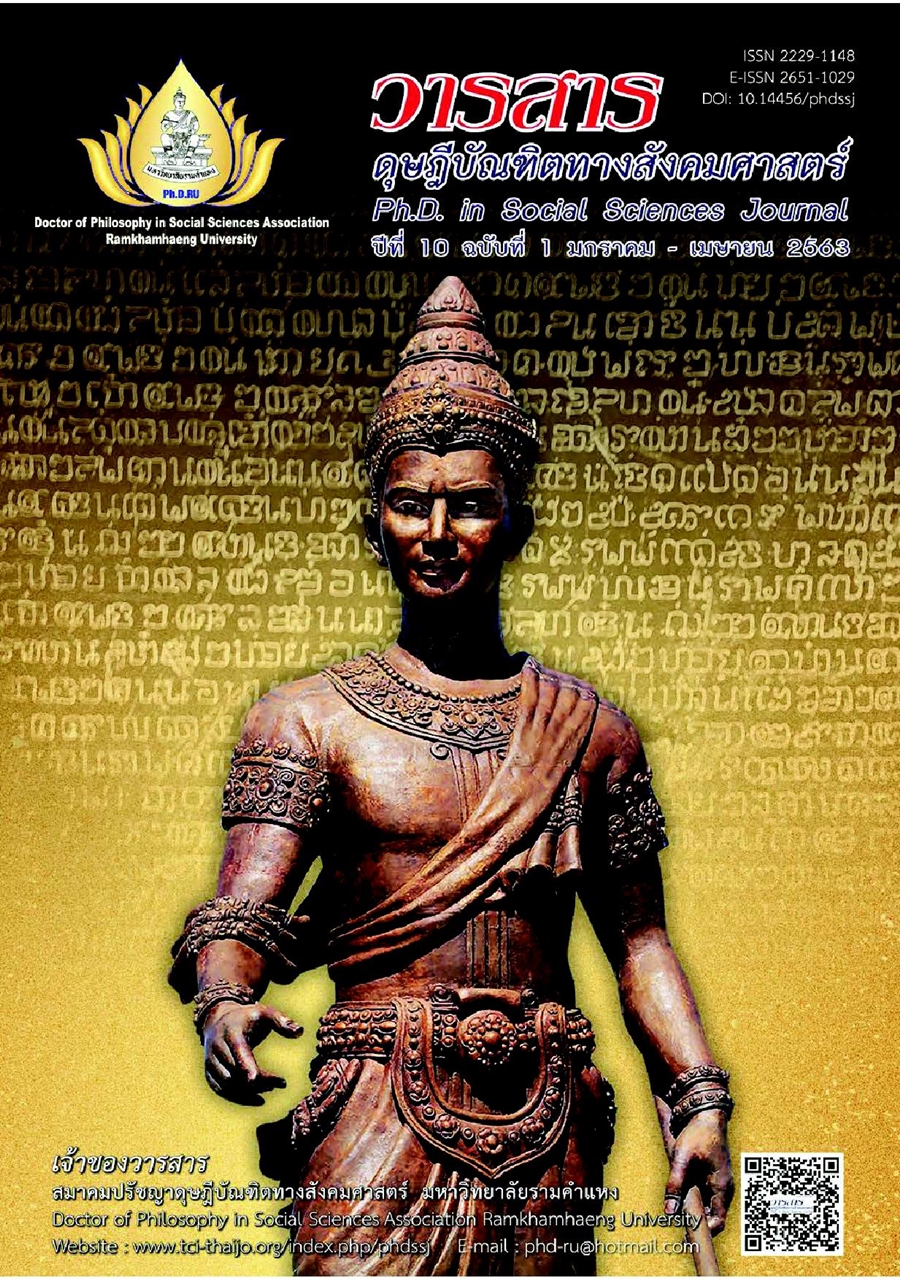Employee Engagement of Commercial Banks Operating in the North of Thailand
Main Article Content
Abstract
The purposes of this research were to study the factors influencing and to construct model of employee engagement of commercial banks operating in the north of Thailand. The study was divided into 2 methods: qualitative research by in - depth interview of managers of commercial banks from 28 samples, and quantitative research by questionnaires from 579 samples, initially using analytical statistics, factor and linear regression analyses.
The result of study found that (1) the factors influencing to employee engagement of commercial banks in the North of Thailand were job independence, job support, salary, motivation, maintenance factors, job satisfaction, and trust., and (2) employee engagement models of commercial banks operating in the north of Thailand were mainly influenced by trust and job satisfaction.
Article Details
Academic articles, research articles, and book reviews in the Ph.D. in Social Sciences Journal are author’s opinions, and not the publisher’s, and is not the responsibility of the Ph.D. in Social Sciences Journal Philosophy Association, Ramkhamhaeng University. (In the case that research is done on human, the researcher has to be trained in Ethics for Doing Research on Human Training and has to produce the evidence of the training).
References
Augier, M., Feigenbaum, E., & Simon, H. A. (2003). Biographical memoirs. Proceedings of American Philosophical Society, 147(2), 193-198.
Bass, B. M. & Avolio, B. J. (1994). Improving organizational effectiveness through transformational leadership. Sage.
Becker, H. S. (1960). Notes on the concept of commitment. American Journal of Sociology, 66(1), 32-40.
Buchinsky, M., Fougre, D., Kramarz, F., & Tchernis, R. (2010). Interfirm mobility, wages and the returns to seniority and experience in the United States. The Review of Economic Studies,77(3), 972-1001.
Burke, C. S., Sims, D. E., Lazzara, E. H., & Salas, E. (2007). Trust in leadership: A multi-level review and integration. The Leadership Quarterly, 18(6), 606-632.
Davis, J. B., Pawlowski, S. D., & Houston, A. (2006). Work Commitments of baby boomers and gen-xers in the IT Profession: generational differences or myth? The Journal of Computer information Systems, 46(3), 43-49.
Department of Employment. (2016). Statistics of registered insured for unemployment compensation benefitsclassified by industrial sectorApril 2016. Retrieved from https://www.doe.go.th [In Thai]
Department of Labour Protection and Welfare. (2010). State and private payroll structure: LaborProtection Act 1998 (B. E. 2541) (Edit 2010). Retrieved from https://www.labour.go.th/th/index.php/labour-laws [In Thai]
Emmema, A. A., Ajjan, N., & Karthikeyan, C. (2012). Factors influencing employee engagement in an entertainment industry. International of Research in Commerce & Management, 3 (8), 35-42.
Ferguson, A. (2005). Employee engagement: Dose it exist, and if so, how dose it relate to performance, other constructs and individual differences. Retrieved from https://www.lifethatworks.com/Employee-Engagement.prn.pdf
Flabbi, L., & Ichino, A. (2001). Productivity, seniority and wages: New evidence from personnel data. Labour Economics, 8(3), 359-387.
Gonzalez, J. V., & Garazo, T. G. (2006). Structural relationships between organizational service orientation, contact employee job satisfaction and citizenship behavior. International Journal of Service Industry Management, 17(1), 23-50.
Hackman, J. R., & Oldham, G. R. (1975). Development of the job diagnostic survey. Journal of Applied Psychology, 60(2), 159-170.
Herzberg, F. (1959). The motivation to work. John Wiley & Sons.
Janpen, S. (2557). Organizational commitment of the officials at the Community Organizations Development Institute (Public Organization). Master's thesis of arts, National Institute of Development Administration. [In Thai]
Kasikornbank. (2016). Explanation and analysis of the management for the year ended December 31, 2016. Retrieved from https://www.kasikornbank.com [In Thai]
Kahn, A. W. (1990). Psychological conditions of personal engagement and disengagement at work. Academic of Management Journal, 33(4), 692-724.
Luhmann, N. (1979). Trust and power - two works by Niklas Luhmann. John Wiley & Sons.
Macey, W. H., & Schneider, B. (2008). The meaning of employee engagement. Industrial and Organizational Psychology, 1(1), 3-30.
Macey, W. H., Schneider, B., Barbera, K. M., & Young, S. A. (2009). Employee engagement: Tools for analysis, practice and competitive advantage. John Wiley & Sons.
Marwan, A.-Z. (2012). The shape of the relationship between salary & job satisfaction: A field study. Far East Journal of Psychology and Business, 7(3), 1-12.
Media-Outreach. (2559). The trend of compensation and welfare in Thailand in 2016, the rate ofresignation increased with increasing responsibility. Retrieved from https://www.mediaoutreach.com/release.php/View/2856 [In Thai]
Melewar, T. C., & Navalekar, A. (2002). Leveraging corporate identity in the digital age. Market ingIntelligence & Planning, 20(2), 96-103.
Mokaya, S. O., & Kipyegon, M. J. (2014). Determinants of employee engagement in the Banking Industryin Kenya: Case of Cooperative Bank. Journal of Human Resources Management and LaborStudies, 2(2), 187-200.
Organ, D. W., Podsakoff, P. M., & MacKenzie, S. B. (2006). Organizational citizenship behavior: Its nature, antecedents, and consequences. Sage.
Phochanasombat, S. (2559). Factors affecting organization commitment of personnel in Offiice of Disease Prevention and Control 8, Nakornsawan Province. Office of Disease Prevention and Control 8. [In Thai]
Seesim, U. (2558). An employee engagement of the employees of Areeya Property Public Company Limited. Master's thesis of business administration, Krirk University. [In Thai]
Tang, T. L. P., Luna-Arocas, R., Sutarso, T., & Tang, D. S. H. (2004). Does the love of money moderate and mediate the income-pay satisfaction relationship?. Journal of Managerial Psychology, 19(2),111-135.
The Gallup Organization. (2010). The state of the global workplace: A worldwide study of employee engagement and wellbeing. Retrieved from https://www.gallup.com/Search/Default.aspx
Woods, A. P. (2008). Leadership factors that influence educational excellence. Education Research, 21, 685.
Woodcock, C. (2012). Transformational leadership and employee engagement. Retrieved from https://www.proquest.com/docview/1027593329
Yiing, L. H., & Ahmad, K. Z. B. (2009). The moderating effects of organizational culture on the relationships between leadership behavior and organizational commitment and between organizational commitment and job satisfaction and performance. Leadership & Organizational Journal, 30(1), 53-86.
Zhu, W., Newman, A., Miao, Q., & Hooke, A. (2013). Revisiting the mediating role of trust in transformational leadership effects: Do different types of trust make a difference?. The Leadership Quarterly, 24(1), 94-105.


